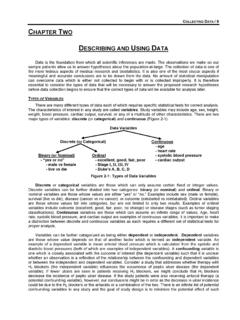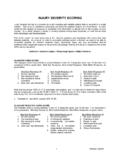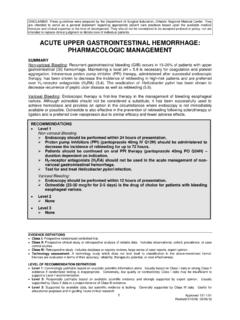Transcription of PERCUTANEOUS ENDOSCOPIC GASTROSTOMY
1 DISCLAIMER: These guidelines were prepared jointly by the Surgical Critical Care and Medical Critical Care Services at Orlando Regional Medical Center. They are intended to serve as a general statement regarding appropriate patient care practices based upon the available medical literature and clinical expertise at the time of development. They should not be considered to be accepted protocol or policy, nor are intended to replace clinical judgment or dictate care of individual patients. PERCUTANEOUS ENDOSCOPIC GASTROSTOMY . SUMMARY. PERCUTANEOUS ENDOSCOPIC GASTROSTOMY (PEG) is not a benign procedure and has its own specific complications. Placement of these tubes facilitates uninterrupted enteral nutrition. There is no prospective randomized data available to guide the optimal timing of placement of these tubes. Timing is based on clinical judgment, experience, and patient condition.
2 PEG tubes should be placed if greater than 4 weeks of enteral nutritional support is expected. RECOMMENDATIONS. Level 1. None Level 2. PEG should be considered in the following situations: Patient will need 4 weeks or more of enteral nutritional support Esophageal obstruction Neurologic dysphagia Prolonged refusal or inability to swallow without terminal illness Supplemental nutrition for patients undergoing chemo- or radiation therapy Life expectancy greater than four (4) weeks Level 3. Timing of PEG tube placement should be based on the physician's clinical judgment. Consider placing a jejunal extension if the patient has prolonged feeding intolerance. INTRODUCTION. The first PEG tube was placed in 1980 by Dr. Michael Gauderer, pediatric surgeon, Dr. Jeffrey Ponsky, endoscopist, and Dr. James Bekeny, surgical resident using a push method.
3 Since that time the procedure has undergone many upgrades and has evolved into a pull method. When placing these tubes, three basic tenants are followed for safe practice: 1) The stomach must be distensible, 2) the endoscopist must be able to identify a blunt push on the stomach from the assistant, and 3) the abdominal wall must transilluminate. If these three tenants are followed, a PEG can be placed without complication or difficulty 95-98% of the time. LITERATURE REVIEW. There are clear indications for the placement of PEG tubes. They are designed to give patients a reliable, comfortable way to receive enteral nutritional support when oral intake is not feasible. EVIDENCE DEFINITIONS. Class I: Prospective randomized controlled trial. Class II: Prospective clinical study or retrospective analysis of reliable data. Includes observational, cohort, prevalence, or case control studies.
4 Class III: Retrospective study. Includes database or registry reviews, large series of case reports, expert opinion. Technology assessment: A technology study which does not lend itself to classification in the above-mentioned format. Devices are evaluated in terms of their accuracy, reliability, therapeutic potential, or cost effectiveness. LEVEL OF RECOMMENDATION DEFINITIONS. Level 1: Convincingly justifiable based on available scientific information alone. Usually based on Class I data or strong Class II. evidence if randomized testing is inappropriate. Conversely, low quality or contradictory Class I data may be insufficient to support a Level I recommendation. Level 2: Reasonably justifiable based on available scientific evidence and strongly supported by expert opinion. Usually supported by Class II data or a preponderance of Class III evidence.
5 Level 3: Supported by available data, but scientific evidence is lacking. Generally supported by Class III data. Useful for educational purposes and in guiding future clinical research. 1 Approved 06/03/2014. Indications The need for nutritional support has to be determined and the underlying cause or disease process should be clearly identified. There are four acceptable indications for PEG placement: 1. The patient has impending esophageal obstruction ( , cancer). 2. If the patient has dysphagia of neurological etiology without obstruction. ( , patients with cerebral vascular accidents, pseudobulbar palsy, or traumatic brain injury). 3. Patients with prolonged refusal to swallow without evidence of concomitant terminal illness. ( , severe depression or mental illness). 4. Patients undergoing chemo- or radiation therapy to oropharynx/esophagus and patients with reduction of appetite and inability to take in adequate oral nutrition.
6 Timing There is no Level I data to guide patient selection and timing of placement/usage of PEG. tubes. Additionally, timing of tube placement is based on Level III data, clinical practice and experience. Retrospective data, consensus statements, literature reviews, and multiple studies conclude that PEG. tubes should be used for enteral nutritional support in patients requiring greater than four (4) weeks of feedings. Furthermore, these tubes may be used for long term decompression of patients with advanced abdominal cancer who suffer from frequent obstruction and/or ileus. It is a more comfortable alternative to nasogastric tube (NGT) decompression for these individuals. There are several small retrospective studies that show that a PEGJ or a jejunal extension is effective at improving nutritional uptake in people with persistent feeding intolerance.
7 However, multiple retrospective studies conclude that PEG/PEGJ is equivalent to NGT with respect to aspiration risk and incidence of pneumonia in patients receiving feeding for less than 30 days. Authors have speculated that the risks are equivalent between both NGT and the jejunal limb; this is secondary to proximal displacement of the limb into the stomach. Contraindications Multiple authors and consensus statements agree that there are situations where PEG tubes are contraindicated. PEG tubes should generally not be offered to patients who will resume normal oral intake within four (4) weeks. These patients may be managed with nasoenteric feeding tubes as their ability to eat returns. During the procedure, if the surgeon is unable to distend the stomach with adequate insufflation, cannot see finger invagination of the stomach through the abdominal wall, or cannot trans- illuminate the abdominal wall, the procedure should be aborted.
8 A PEG tube should not be offered if life expectancy is less than 4 weeks, there is no chance for physiological recovery, or PEG cannot improve the patient's quality of life. Absolute Contraindications for PEG placement Life expectancy less than four (4) weeks Cirrhosis with any of the following: hepatomegaly, splenomegaly, moderate ascites, portal hypertension, gastric and/or esophageal varices Esophagus in discontinuity Hemodynamic instability Septic shock Coagulopathy (INR > ). Relative Contraindications for PEG placement Nutritional support requirement less than four (4) weeks Advanced dementia / Alzheimer's disease Metastasis to abdominal wall Ventral hernia in proximity to PEG insertion site Previous gastric / abdominal surgery Esophageal cancer with possibility of gastric conduit reconstruction Myocardial infarction within past three (3) months 2 Approved 06/03/2014.
9 Complications There is a wide host of complications associated with PEG tube placement. Yip et al (2004) found that in 230 patients, balloon GASTROSTOMY and gastrojejunostomy had a higher complication rate than mushroom GASTROSTOMY tubes at , , and , respectively. The following is a list of the most common complications associated with PEG tubes and there placement. 1. Benign pneumoperitoneum This occurs in about 50% of PEG tubes placed as a result of insufflated air escaping from the needle puncture site. No treatment is necessary as long as the patient has a benign abdominal examination. 2. Small bowel obstruction This type of injury occurs secondary to a volvulus around slack in the tube or distal migration of the internal bumper through the pylorus. 3. Abdominal wall bleeding This complication may occur when the gastroepiploic artery or a perforating branch is punctured by the placement of the tube.
10 The bleeding may be controlled with bumper tamponade. 4. Abscess and wound infection This complication is seen in 18% of patients without pre-operative antibiotics and about 3% of patients who did receive pre-operative antibiotics. 5. Buried bumper syndrome This occurs in of patients. Even if the patient is asymptomatic, the PEG tube should be revised. Due to slow pressure necrosis and ulceration, average time to diagnosis is 4 months. 6. GI Bleeding/Ulceration This occurs in of patients. Esophagitis is the most common ENDOSCOPIC finding in patients with PEG associated GI bleed. Up to 15% of people with PEG tubes will have a concurrent ulcer, either gastric or duodenal. 7. Ileus or gastroparesis Prolonged ileus occurs in 1-2% of patients. 8. PEG tube dislodgement Most often occurs when the patient is combative or confused; occurs in of patients.










